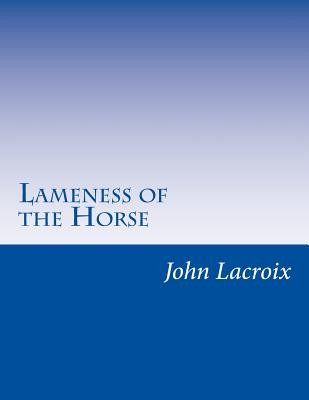
- We will send in 10–14 business days.
- Author: John Victor LaCroix
- Publisher: CreateSpace Independent Publishing Platform
- Year: 2014
- Pages: 142
- ISBN-10: 1499767862
- ISBN-13: 9781499767865
- Format: 21.6 x 27.9 x 0.8 cm, softcover
- Language: English
- SAVE -10% with code: EXTRA
Reviews
Description
Lameness is a symptom of an ailment or affection and is not to be considered in itself as an anomalous condition. It is the manifestation of a structural or functional disorder of some part of the locomotory apparatus, characterized by a limping or halting gait. Therefore, any affection causing a sensation and sign of pain which is increased by the bearing of weight upon the affected member, or by the moving of such a distressed part, results in an irregularity in locomotion, which is known as lameness or claudication. A halting gait may also be produced by the abnormal development of a member, or by the shortening of the leg occasioned by the loss of a shoe. For descriptive purposes lameness may be classified as true and false. True lameness is such as is occasioned by structural or functional defects of some part of the apparatus of locomotion, such as would be caused by spavin, ring-bone, or tendinitis. False lameness is an impediment in the gait not caused by structural or functional disturbances, but is brought on by conditions such as may result from the too rapid driving of an unbridle-wise colt over an irregular road surface, or by urging a horse to trot at a pace exceeding the normal gait of the animal's capacity, causing it to "crow-hop" or to lose balance in the stride. The latter manifestation might, to the inexperienced eye, simulate true lameness of the hind legs, but in reality, is merely the result of the animal having been forced to assume an abnormal pace and a lack of balance in locomotion is the consequence.
- Author: John Victor LaCroix
- Publisher: CreateSpace Independent Publishing Platform
- Year: 2014
- Pages: 142
- ISBN-10: 1499767862
- ISBN-13: 9781499767865
- Format: 21.6 x 27.9 x 0.8 cm, softcover
- Language: English English
Lameness is a symptom of an ailment or affection and is not to be considered in itself as an anomalous condition. It is the manifestation of a structural or functional disorder of some part of the locomotory apparatus, characterized by a limping or halting gait. Therefore, any affection causing a sensation and sign of pain which is increased by the bearing of weight upon the affected member, or by the moving of such a distressed part, results in an irregularity in locomotion, which is known as lameness or claudication. A halting gait may also be produced by the abnormal development of a member, or by the shortening of the leg occasioned by the loss of a shoe. For descriptive purposes lameness may be classified as true and false. True lameness is such as is occasioned by structural or functional defects of some part of the apparatus of locomotion, such as would be caused by spavin, ring-bone, or tendinitis. False lameness is an impediment in the gait not caused by structural or functional disturbances, but is brought on by conditions such as may result from the too rapid driving of an unbridle-wise colt over an irregular road surface, or by urging a horse to trot at a pace exceeding the normal gait of the animal's capacity, causing it to "crow-hop" or to lose balance in the stride. The latter manifestation might, to the inexperienced eye, simulate true lameness of the hind legs, but in reality, is merely the result of the animal having been forced to assume an abnormal pace and a lack of balance in locomotion is the consequence.


Reviews